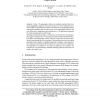Free Online Productivity Tools
i2Speak
i2Symbol
i2OCR
iTex2Img
iWeb2Print
iWeb2Shot
i2Type
iPdf2Split
iPdf2Merge
i2Bopomofo
i2Arabic
i2Style
i2Image
i2PDF
iLatex2Rtf
Sci2ools
MICCAI
1999
Springer
1999
Springer
Fully Automatic 3D/2D Subtracted Angiography Registration
Abstract. Today, 3-D angiography volumes are routinely generated from rotational angiography sequences. In previous work [7], we have studied the precision reached by registering such volumes with classical 2-D angiography images, inferring this matching only from the sensors of the angiography machine. The error led by such a registration can be described as a 3-D rigid motion composed of a large translation and a small rotation. This paper describes the strategy we followed to correct this error. The angiography image is compared in a two-step process to the Maximum Intensity Projection (MIP) of the angiography volume. The first step provides most of the translation by maximizing the cross-correlation. The second step recovers the residual rigid-body motion, thanks to a modified optical flow technique. A fine analysis of the equations encountered in both steps allows for a speed-up of the calculations. This algorithm was validated on 17 images of a phantom, and 5 patients. The re...
| Added | 04 Aug 2010 |
| Updated | 04 Aug 2010 |
| Type | Conference |
| Year | 1999 |
| Where | MICCAI |
| Authors | Erwan Kerrien, Marie-Odile Berger, Eric Maurincomme, Laurent Launay, Régis Vaillant, Luc Picard |
Comments (0)

